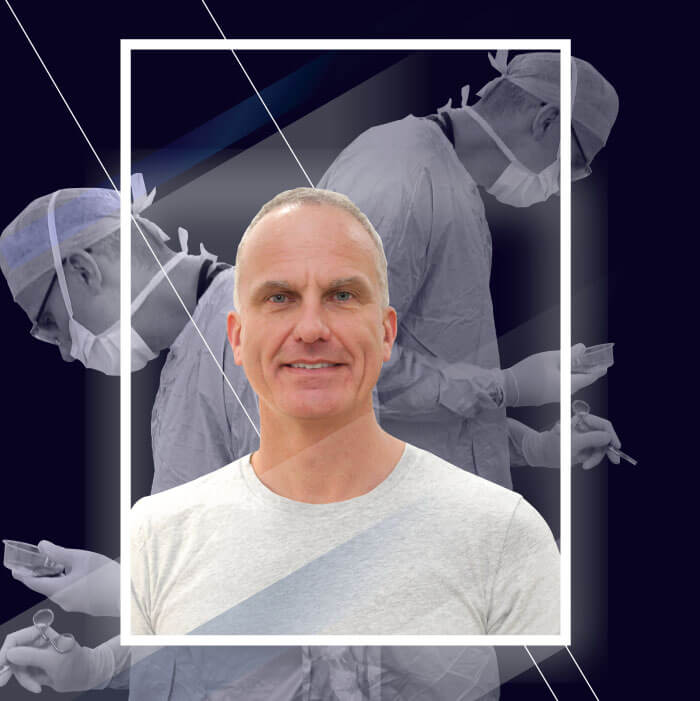
When I was at the University in Edinburgh, I felt drawn towards a practical specialty, and surgery was the obvious choice for me. My father was a photographer; working with him inspired my interest in optics, and so I decided on ophthalmology in my second year at medical school to combine my two passions
I was privileged to work as the house officer for Sir David Carter on the hepatobiliary unit at the Royal Edinburgh Infirmary. Carter was an imposing figure, but despite that he was still able to show compassion with his patients, and his successful academic work was an example to me of how surgery and research could be combined.
At Moorfields, I was lucky to meet Bill Aylward, who taught me to have a logical approach to vitreoretinal surgery, which makes planning even the most challenging cases very straightforward. In genetics, I was trained and inspired by Tony Moore, who sought to understand inherited retinal degeneration by the action of the gene involved. Understanding the genetic mechanisms of a disease is the first step towards developing a molecular treatment.
The introduction of sutureless vitrectomy and improved microscopy, such as intraoperative OCT, has made the job of a vitreoretinal surgeon far more predictable than it was in my day as a fellow. For instance, a large proportion of our redo retinal detachments were caused by entry-site breaks, which are now rare. Post-operatively, we would routinely deal with high pressures due to the surgical trauma of removing the conjunctiva and suturing the ports tightly. The more predictable outcomes we have now make it much easier to combine a career as an academic and a vitreoretinal surgeon because our work is more outpatient based.
Developing our choroideremia and X-linked retinitis pigmentosa (RPGR) gene therapy programs are, in my opinion, wonderful examples of how one might combine research with clinical practice. In both cases, I have been privileged to design the viral vector (in terms of programming the genetic code and testing it in the lab), develop the surgical technique for administering the gene therapy treatment, and lead the first in-human clinical trials. To be successful has required a collection of skills, including the ability to raise funding, which is often overlooked as an academic requirement – clinical trials are expensive to run.
I am very busy with the Phase 3 clinical trials – the final step of the basic science that started in my lab almost 10 years ago. Beyond that, we have some very interesting projects being developed in the lab, including gene therapy for larger genes, and innovative gene silencing techniques, such as CRISPR interference, to treat dominant diseases. We look forward to bringing these to trial in the next few years.
Achieving a solid base of clinical training is the first step. To be a successful clinical academic, you really only need to do one thing: publish papers. Publications are the currency of academia. To do clinical trials, you need funding, and this can most easily be achieved initially by working with commercial sponsors. Once you have an understanding of how clinical trials work, you can then start to design your own, and hopefully with some publications behind you, the prospect of funding those trials independently should not be too difficult. Beyond that, teamwork and leadership are key skills – you need a team of people aligned to the same goal of developing treatments for blindness
Gene therapy treatments are clearly going to take off for single gene disorders, but age-related macular degeneration remains an unmet need because several genes are implicated in it. I expect to see a breakthrough in AMD gene therapy within the next 5-10 years. I think we will also see improved treatments in diabetic maculopathy that might involve cell-based therapies regenerating the retinal vasculature.
In ophthalmology, we do operations relatively well. For instance, in cataract surgery the risk of posterior capsule rupture for most surgeons is around 1 percent and, if this happens, the results are not so bad because patients rarely need to be readmitted for further surgery. And that’s why I mainly see opportunities for robotics in developing new operations that we currently cannot perform optimally. Subretinal injection of cells or gene therapy, optic nerve injections, and cannulation of vessels in the retina are example procedures that might be achievable with robotic precision.
Without a doubt, the dream of everyone in my lab is to see one of our research programs become an approved treatment. We are not far away from that goal. It has been a long path, but the end is in sight.
